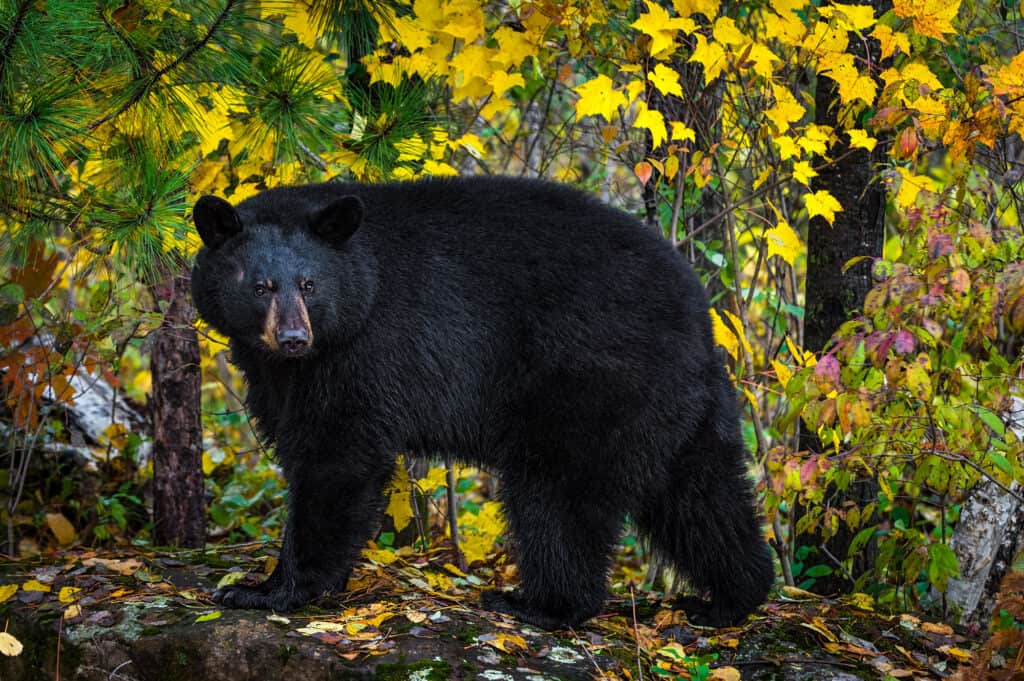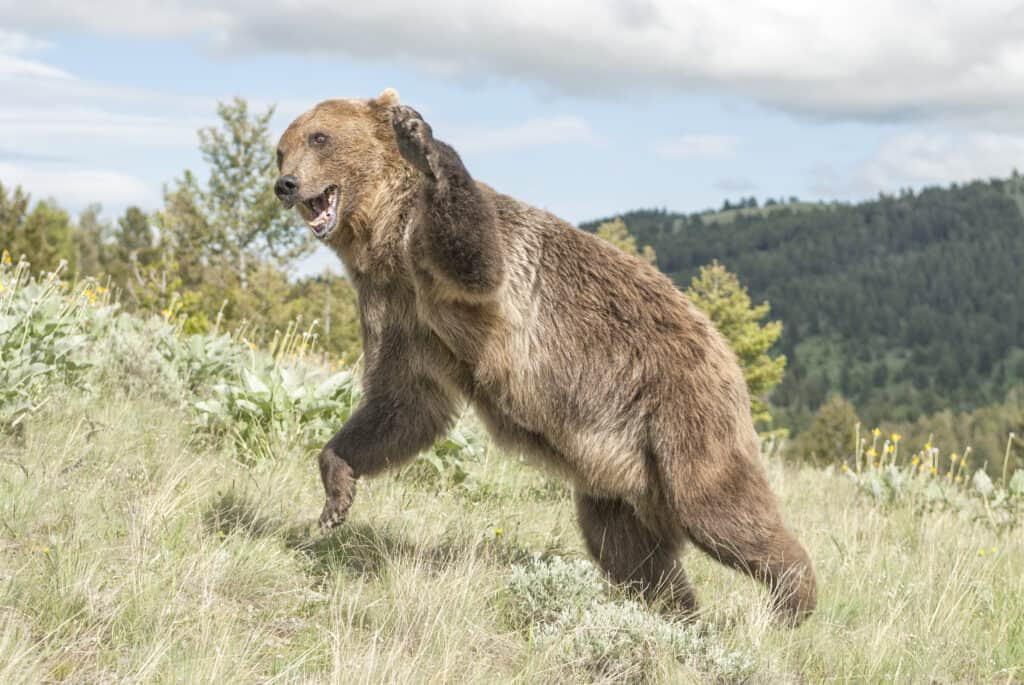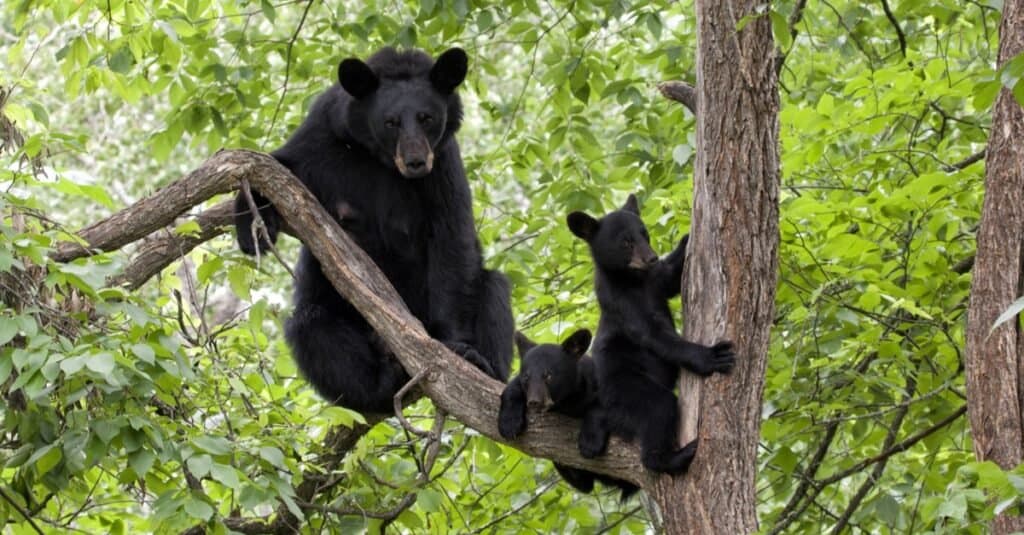Idaho is home to many miles of protected wilderness and breathtaking mountains, making it the perfect place to find an array of wildlife. Among its many species are grizzly bears, once common in the state, though their numbers dwindled to nothing in the 20th century. Recently, grizzles have made a comeback, though their populations are tiny compared to the plentiful black bear. So which species has claimed fame as the largest bear ever caught in Idaho? Read on to find out!

The largest bear ever caught in Idaho was a black bear.
©Holly Kuchera/Shutterstock.com
The Largest Bear Ever Caught in Idaho
According to official Idaho Fish and Game records, the largest bear ever caught in Idaho was a black bear with a skull measurement of 22 1/8 inches. Hunter Tim Bartlett brought the bear down in 1991, shattering hunter Harold Boyack’s previous record from 1976. Boyack’s bear skull measured 21 13/16 inches. Although, there are grizzly bears in Idaho that would presumably have larger skulls and mass, hunting them is illegal.
Bear in Idaho: Types and Appearance

You can find grizzlies in Idaho.
©outdoorsman/Shutterstock.com
Idaho has two types of bears: black bears (Ursus americanus) and grizzly bears (Ursus arctos horribilis). Grizzly bears are typically slightly larger with an average weight of 200 to 600 pounds. They stand as tall as six to seven feet with a shoulder height of 3.5-4 feet. In Idaho, adult male black bears weigh between 126-557 pounds while females weigh between 90-375 pounds. They stand between four and seven feet tall with an average shoulder height of up to 3-3.25 feet.
Grizzly bears are brown in color, though their “grizzled” look comes from the lighter tips of their hair. Black bears come in a variety of colors: black, black with white chest markings, brown, cinnamon, blond, bluish-grey, and white. In Idaho, their pelts are normally black, brown, or cinnamon. Unlike black bears, grizzlies have a distinct hump on their backs.
Idaho Bear: Habitat
Although grizzlies once roamed throughout the entire state of Idaho, they currently remain within the northern and eastern regions, notably around Yellowstone National Park. Other areas with breeding populations include the Selkirk Mountains, the Bitterroot Ecosystem Recovery Zone, and the Cabinet-Yaak Ecosystem. Black bears are much more widespread throughout Idaho, especially in the northern, central, and eastern counties.
Grizzly bears historically occupied the Great Plains, including the Salmon River Canyons, the eastern prairies of Idaho, and its interior mountains. Overhunting and habitat loss caused their extirpation over the course of the 20th century, which has only reversed in recent years. Their preferred habitats are mixed forests, meadows, and grasslands. Black bears also prefer forests, though they can survive in grasslands, scrublands, deserts, and swamps.
How Many Bears Are There in Idaho?

In Idaho, there are between 20,000 to 30,000 black bears.
©Debbie Steinhausser/Shutterstock.com
There are between 20,000 and 30,000 black bears in Idaho. By contrast, the state only has 80 to 100 grizzly bears, many of them in the Selkirk Mountains. An estimated 900,000 black bears roam across North America, making them far more populous than the world’s 110,000 brown bears. Approximately 60,000 grizzly bears inhabit North America, most of them in Alaska and Canada; only 1,800 or so grizzlies currently live in the lower 48 states.
Because of their increasing populations, the IUCN lists black bears as Least Concern as of 2016. It gave the same designation to brown bears that year, reflecting their stable populations.
Is It Legal to Hunt Bears in Idaho?
Both state and federal law currently protects grizzly bears in Idaho. However, it is legal to hunt black bears with a license. Government regulations permit the use of both hounds and bait stations in the pursuit of black bears. See the Idaho Fish and Game website for current black bear seasons and regulations.
Are Bears Dangerous?
Both grizzly and black bears are dangerous when cornered or provoked. They also may become aggressive in their search for food, especially as their caloric intake increases in preparation for winter. Human food tends to be more calorie-dense than other food sources and is therefore more attractive. It is never a good idea to feed a wild bear as it may habituate them, leading to increased aggression and potential fatalities.
Conclusion
Although official records list the largest bear ever caught in Idaho as a black bear, grizzly bears have returned to the state and may become fair game for hunting in the near future. For tips on how to coexist peacefully with bears in Idaho, see the Idaho Fish and Game’s Living with Black Bears guide.
Up Next:
- Discover the Largest Bear Ever Caught in Utah
- Discover the Largest Bear Ever Caught in Arizona
- The Largest Black Bear in History
- Discover the Largest Brown Bear Ever
- Discover the Largest Black Bear Ever Caught in Arizona
The photo featured at the top of this post is © Wild Art/Shutterstock.com
Sources
- Idaho Fish and Game, Available here: https://idfg.idaho.gov/hunt/records
- Idaho Fish and Game (1970) idfg.idaho.gov/conservation/grizzly-bears
- Idaho Fish and Game (1970) idfg.idaho.gov/hunt/big-game/black-bear
Thank you for reading! Have some feedback for us? Contact the AZ Animals editorial team.






